
When it comes to powering mobile generators, air compressors and other larger equipment in the construction industry, diesel still reigns supreme. Not to say there aren’t alternatives. In Europe, the high cost of fossil fuels, coupled with an economy and culture that is more “green-aware” than we are in the U.S., has helped advance the market for alternative energy sources.
Conversely, the relatively low cost of gasoline and diesel in the U.S., and inertia, or an overall lack of incentive to adapt to different fuel sources, has slowed the growth in popularity of alternative fuels.
Read next: Diesel Alternatives for the Non-Road Sector
“In many applications, including the use of generators in the [construction and] rental market, users are often more comfortable with diesel than other fuels,” says Michael Goche, director of product management, Generac Mobile. “They use diesel fuel for their other equipment, it is readily available and it is relatively inexpensive compared to converting to an alternative energy source.”
“When Tier 4 technology was introduced into diesel engines, it was questionable whether or not consumers would pay the higher costs,” notes Jeremy Bailey, air products manager, Doosan Portable Power. “We looked at gasoline and electric alternatives for our air compressors, just as other groups in the company looked at alternatives for their equipment. But in the end, most consumers decided to stay with diesel.
“When it comes to choosing between diesel and another alternative fuel source, it comes down to ROI,” he adds, “and consumers found diesel fuel to be the best alternative.”
Close Relatives
Over the years, gaseous fuels have become more popular for certain applications.
Gaseous generators, for example, have found an application in the oil and gas industry, where regulations have encouraged the use of well-head gas to minimize flare-offs. Used to run pump jacks and submersible pumps, the application is especially attractive where there is no available power grid, and it is very cost effective. As well-head gas needs to be cleaned to remove dirt, water and other impurities, most manufacturers offer an onboard scrubber system.
Read next: 3 Machines Powered by Propane That May Surprise You
Natural gas and propane have also found applications for standby power in the commercial, industrial and residential marketplace. Doosan, Generac Mobile and Kohler natural gas generators, for example, can operate on propane as well as natural gas.
“Kohler launched its gaseous mobile generator line in 2014. These units are typically pulled behind a truck to a specific location where they can run for long hours in prime and standby applications,” says Anne Feudner, product manager, Kohler mobile generators. “They’re ideal for remote construction sites and large-scale special events, and excellent for storm recovery operations — anywhere dependable power is needed.”
Read next: Natural Gas Basics 101: What Contractors Need to Know About CNG and LNG
Unlike diesel, natural gas and propane don’t degrade over time. “Propane is reliable and readily available and is typically the least expensive option, so it is sometimes preferred,” Feudner comments. “We estimate that our liquid propane (LP) units can save an end user about 15% to 20% on fuel costs. But it really comes down to which fuel source is best suited to a specific application. Rental customers today definitely appreciate the flexibility to choose.”
Kohler propane mobile generators can be utilized for most of the same applications as diesel fuel models. The onboard LP tank is built for a 24-hour run time, while connection to an external LP or natural gas supply offers extended usage. If propane runs out or isn’t available at the site, an optional onboard tank can be used to switch to an on-site fuel supply.
Green Opportunity
Like the auto industry, the construction industry has seen opportunity utilizing hybrid technology.
“Light towers are a good example where hybrid technology has a place. A generator can charge batteries during the day, which in turn would provide quiet power to light an evening event,” says Goche. “The challenge for the rental store and its customers is balancing the additional initial cost for the battery and engine combination. Large gaseous generators provide continuous power in remote well-head locations and standby power in commercial, industrial and residential settings.
Large gaseous generators provide continuous power in remote well-head locations and standby power in commercial, industrial and residential settings.
“LED lights, though, are becoming more popular in light towers. They are dramatically more efficient than metal halide lights, and improving battery life and output will only serve to make hybrid technology more cost effective and viable,” he adds.
Goche believes “going green” will be the next opportunity. “In 2013, Generac purchased Italy-based Tower Light and has since incorporated its hybrid technology into its green line of light tower products that feature rechargeable batteries using both shore power (plug-in) and the diesel generator/battery technology,” he points out.
Indeed, battery technology continues to improve, as evidenced by the evolution and growing popularity of battery-powered hand tools, chain saws and larger equipment like hammers and rammers. Even larger battery-powered equipment has made its way into the European construction market, but it has been slow to catch on in this country.
“The European market is more receptive to battery and electric power because of tougher emissions standards and higher fuel costs there than in the U.S.,” says Bailey. But as battery life, power output and rechargeability improve, he predicts it will become more attractive on this side of the Atlantic.
Harnessing Solar Power
One of the most reliable sources of renewable energy lies some 90+ million miles from earth. Harnessing this energy is something Tycon Systems has been doing for the last 10 years. The Utah-based manufacturer designs and manufactures turnkey remote power systems such as RemotePro, which utilizes solar and wind, and outdoor uninterruptible backup power systems (UPSPro).
These products have a variety of applications. “This industry is constantly changing and improving, and the applications for solar power are nearly endless,” says Seth Allen, Tycon sales and marketing manager.
The company specializes in powering low-voltage equipment such as irrigation pumps, security cameras, wireless communication, outdoor lighting, etc., as well as hard to reach areas where being on the grid may be too costly or virtually impossible to accommodate. It also has a mobile trailer wind/solar power system for those needing temporary mobile power.
When employed in conjunction with battery backup, the power can be available 24/7. “Typically, we look at the application and the number of hours of peak sunlight available during the day. Then, we determine how much solar and battery backup is needed to supply power for a specific time period, perhaps for a couple of hours or 24/7,” Allen explains.
“Powering lights in remote locations such as those common in the oil and mining industries has become a popular application for solar power,” he continues. “Unlike gasoline- or diesel-powered light towers that require routine maintenance and refueling, solar-powered units effortlessly convert the sun’s rays into power. Another advantage is that the conversion is quiet, making these light towers popular... where noise can be an issue.”
Read next: New Solar Systems Solve Construction's Dead Battery Problem
For the more traditional uses for light towers, diesel still dominates and likely will do so for a long time, says Doosan’s Bailey. “Again, it comes down to ROI — and using batteries in conjunction with photo cells as an alternative to diesel is not competitive,” he asserts. “Rest assured, though, that all light tower manufacturers either have already or will in the future experiment with the technology. It isn’t there yet, but it will be.”
The sun isn’t the only domain for Tycon Systems. It also offers a 400-watt wind turbine for stand-alone power, storing energy in a battery bank or to work in conjunction with solar panels.
“Available sunlight and wind can both be unpredictable,” Allen acknowledges. “The sun is constant, but available daylight hours and cloudless skies for peak solar panel efficiency are not, and wind is even more unpredictable.
“When used together, though, they provide a more consistent source of power,” he states. “Both technologies look to become even more efficient over time. Solar panels, for example, are currently somewhere between 20% and 25% efficient, but with people like Elon Musk leading the charge, expect solar panels to continue to increase in efficiency.”
More Choices Ahead
On the portable generator side of its business, Kohler has introduced a tri-fuel generator. “This product allows a user to run certain Kohler portable generators on three different fuels: propane, natural gas and gasoline,” Feudner notes. “To switch between the three fuels, the user simply turns a dial and swaps out the fuel hose. So, users can choose how they want to power their portable generator based on what’s available to them.”
Batteries, hybrid technology, propane and natural gas will continue to bite away at the diesel pie. Other prospects, including fuel cells, are waiting to get into the game. More efficient than metal halide, LED lights will serve to make hybrid technology even more viable. The challenge is the additional cost for the battery and engine combination.
More efficient than metal halide, LED lights will serve to make hybrid technology even more viable. The challenge is the additional cost for the battery and engine combination.
“Doosan has a fuel cell group, but the technology of converting a chemical reaction between hydrogen fuel and oxygen into energy is still not ready for applications in the construction industry,” says Bailey. “Currently, it’s more appropriate for supplying energy to buildings and smaller electrical grids.”
Size and cost are the two main stumbling blocks for both hybrid and dedicated battery power applications. “Batteries make sense in hand tools and smaller equipment when a user can afford to buy a backup battery,” says Bailey. “That approach doesn’t work so well when factoring in the much higher cost for larger batteries in larger equipment.”
For example, consider a scenario where a construction deadline has crews working a 14-hour day with electric equipment that only runs eight hours per charge. And it takes the batteries several hours to recharge.
“Then there’s the acquisition cost of purchasing the equipment, along with the price per horsepower value,” Bailey continues. “The technology isn’t quite there for electric vehicles, but car buyers will be a good indicator of when it is.
“Look for the auto industry to lead the way,” he says. “As electric cars become more affordable, run longer between charges and need less time to recharge, they will become more attractive to consumers and the technology more usable in not only generators and air compressors but in larger off-road equipment, as well.”
A similar scenario will likely play out for other fuel sources such as hybrid technologies and fuel cells. Compliance, noise issues and special applications continue to make them an attractive alternative, but until the ROI or price per horsepower value comes down, widespread acceptance in the construction industry remains several years down the road.




















